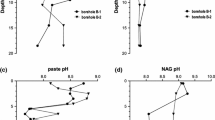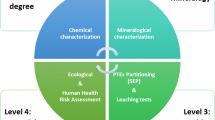Abstract
Mineral extraction and processing, especially metal mining, produces crushed and milled waste; such material, exposed to weathering, poses the potential threat of environmental contamination. In this study, mill tailings from inactive Pb-Zn mines in New Mexico, southwest USA, have been examined for their potential environmental impacts by means of detailed mineralogical and geochemical characterization. The principal ore minerals remaining in the tailings material are sphalerite, chalcopyrite, and very minor galena, smithsonite, and cerrusite, accompanied by the gangue minerals pyrite, pyrrhotite, magnetite, hematite, garnet, pyroxene, quartz, and calcite. White precipitate occurring on tailings surfaces is composed of gypsum and hydrated magnesium sulfates. Pyrite is mostly unaltered or shows only micron-scale rims of oxidation (goethite/hematite) in some surface samples. This iron oxide rim on pyrite is the only indication of weathering-derived minerals found by microscopy. There are variations in element concentrations with depth that reflect primary variations through time as the tailings ponds were filled. Cadmium and Zn concentrations increase with depth and Ag and Pb are low for the uppermost core samples, while Cu, Ni, and Co concentrations are generally high for the uppermost core samples. These elemental distributions indicate that little or no leaching has taken place since emplacement of the tailings because no accumulation or enrichment of these metals is observed in Hanover tailings, even in reducing portions of tailings piles. Element concentrations of surface samples surrounding the tailings reflect underlying mineralized zones rather than tailings-derived soil contamination. We observed no successive decreasing metal concentrations in prevalent wind directions away from the tailings. Stream sediment samples from Hanover Creek have somewhat elevated Zn, Cd, and Pb concentrations in areas that receive sediments from erosion of the tailings. However, input from tributaries downstream of the ponds appears to be principal source of heavy metals in Hanover Creek. The results of this study indicate that there is low risk for groundwater heavy-metal contamination from Hanover tailings. Tailings material do not show significant geochemical oxidation/alteration or metal leaching with depth. Our studies indicate that neutralizing minerals present in the tailings are sufficient to keep the tailings material chemically stable. Geochemically, however, tailings materials are being eroded and may pose a threat to Hanover Creek via siltation.
Similar content being viewed by others
References
Adrian Brown Consultants, Inc. (1991) Engineering evaluation and cost analysis of tailings removal from the Cleveland Mill, Silver City, New Mexico. Adrian Brown Consultants, Inc. Denver, CO. Report 1217/910122, 77 pp
Allison JD, Brown DS, and Novo-Gradac KJ (1991) MINTEQA2/PRODEFA2, a geochemical assessment model for environmental systems: version 3.0 users manual. US Environmental Protection Agency, Athens, GA. EPA/600/3-91/021, 106 pp
Alpers CN and Brimhall GH (1989) Paleohydrologic evolution and geochemical dynamics of cumulative supergene metal enrichment at La Escondida, Atacama Desert, Northern Chile. Econ Geol 84:229–255
Alpers CN, Nordstrom DK, and Thompson JM (1994) Seasonal variations of Zn/Cu ratios in acid mine water from Iron Mountain, California. In: Alpers CN and Blowes DW (Eds), Environmental geochemistry of sulfide oxidation. Symposium series 550. Washington, DC: American Chemical Society. pp 324–344
Anderson JM (1982) Characteristics of leachal capping and techniques of appraisal. In: Titley SR (Ed), Advances in geology of the porphyry copper deposits, Southwestern North America. Tucson: University of Arizona Press. pp 275–295
Baker T (1993) Mobility of heavy metals in soils and tailings at the Hanover and Bullfrog tailings sites, Silver City, New Mexico. Masters thesis, New Mexico Institute of Mining and Technology. Open file report no 393, New Mexico Bureau of Mines and Mineral Resources, Socorro, NM. 71 pp
Balistrieri L, Brewer PG, and Murray JW (1981) Scavenging residence times of trace metals and surface chemistry of sinking particles in the deep ocean. Deep-Sea Res 28A: 101–121
Balistrieri LS and Murray JW (1982) Adsorption of Cu, Pb, Zn, and Cd on goethite from major ion seawater. Geochim Cosmochim Acta 46:1253–1267
Benjamin MM and Leckie JO (1981) Multiple site adsorption of Cd, Cu, Zn, and Pb on amorphous iron oxide. J Colloid Interface Sci 79:209–221
Borek SL (1994) Effect of humidity on pyrite oxidation. In: Alpers CN and Blowes DW (Eds), Environmental geochemistry of sulfide oxidation. Symposium series 550. Washington, DC: American Chemical Society. pp 31–44
Chambers JC and Sidle RC (1991) Fate of heavy metals in an abandoned lead-zinc tailings pond: I. Vegetation. J Environ Qual 20: 745–751
Davis JA (1984) Complexation of trace metals by adsorbed natural matter. Geochim Cosmochim. Acta 48:670–691
Davis JA, Fuller CC, and Cook AD (1987) A model for trace metal sorption processes at the calcite surface: Adsorption of Cd2+ and subsequent solid solution formation. Geochim Cosmochim Acta 51:1477–1490
Davis A, Ruby MV, and Bergstrom PD (1992) Bioavailability of arsenic and lead in soils from Butte, Montana, Mining District. Environ Sci Technol 26:461–468
Elliott HA, Liberati MR, and Huang CP (1986) Competitive adsorption of heavy metals by soils. J Environ Qual 15:214–219
Felmy AR, Girvin DC, and Jenne EA (1984) MINTEQ—a computer program for calculating aqueous geochemical equilibria. US Environmental Protection Agency, Athens, GA. EPA-600/3-84-032.
Fuge R, Pearce FM, Pearce NJG, and Perkins WT (1994) Acid mine drainage in Wales and influence of ochre precipitation on water chemistry. In: Alpers CN and Blowes DW (Eds), Environmental geochemistry of sulfide oxidation. Symposium series 550. Washington, DC: American Chemical Society. pp 261–274
Gislason SR and Arnorsson S (1993) Dissolution of primary basaltic minerals in natural waters: Saturation state and kinetics. Chem Geol 105:117–135
Gregorio FD and Massoli-Novelli R (1992) Geological impact of some tailings dams in Sardinia, Italy. Environ Geol Water Sci 19:147–153
Hoffman SJ (1986) Soil Sampling. In: Fletcher WK, Hoffman SJ, Mehrtsens MB, Sinclair AJ, and Thomson I (Eds), Exploration geochemistry: Design and interpretation of soil surveys. Reviews in Economic Geology, Vol 3. pp 39–77
Jensen ML and Bateman AM (1979) Economic mineral deposits, 3rd ed. New York: John Wiley & Sons. 593 pp
Johnson GD (1987) Characterization of the spatial variability of mill tailings hydraulic properties: A statistical and geostatistical analysis. Unpublished independent study paper, Socorro, New Mexico. New Mexico Institute of Mining and Technology
Jones WR and Hernon RM (1973) Ore deposits and rock alteration of the Santa Rita quadrangle, Grant County, New Mexico. US Geological Survey, Washington, DC. PB 214 371, 102 pp
Jones WR, Heron RM, and Moore SL (1967) General geology of Santa Rita Quadrangle, Grant County, New Mexico. US Geological Survey Professional Paper 555, 144 pp. With accompanying 1:24,000 scale geological map GQ-306
Lasky SG and Wootton TP (1932) Metal resourcees of New Mexico. New Mexico School of Mines, State Bureau of Mines and Mineral Resources Bulletin 7, 178 pp
Levinson AA (1980) Introduction to exploration geochemistry, 2nd ed. Wilmette, Illinois Applied Publishing. 924 pp
Maynard JB (1983) Geochemistry of sedimentary ore deposits. New York: Springer-Verlag. 305 pp
McBride MB (1980) Chemisorption of Cd2+ on calcite surfaces. Soil Sci Soc Am J 44:26–28
McLaren RG and Crawford DV (1973) Studies on soil copper: II. The fraction of copper in soils. J Soil Sci 24:172–181
Millero FJ, Sotolongo S, and Izaguirre M (1987) The oxidation kinetics of Fe(II) in seawater. Geochim Cosmochim Acta 51:793–801
Nordstrom K (1995) Fundamentals of aqueous geochemistry and trace metal mobility. In: Plumlee GS and Logsdon MH (Eds), The environmental geochemistry of mineral deposits, Reviews in Economic Geology, Vol 6 (in press)
Papadopoulos P and Rowell DL (1988) The reactions of cadmium with calcium carbonate surfaces. J Soil Sci 39:23–36
Plumlee GS (1995) The environmental geology of mineral deposits. In: Plumlee GS and Logsdon MH (Eds), The environmental geochemistry of mineral deposits. Reviews in Economic Geology, Vol 6 (in press)
Rimstidt JD, Chermak JA, and Gagen PM (1994) Rates of reaction of galena, sphalerite, chalcopyrite, and arsenopyrite with Fe(III) in Acidic solutions. In: Alpers CN and Blowes DW (Eds), Environmental geochemistry of sulfide oxidation. Symposium series 550. Washington, DC: American Chemical Society. pp 2–13
Schmitt HA (1939) Outcrops of ore shoots: Southwestern United States and Northern Mexico. Econ Geol 34:654–673
Sidle RC, Chambers JC, and Amacher MC (1991) Fate of heavy metals in an abandoned lead-zinc tailings pond: II. Sediment. J Environ Qual 20:752–758
Singer PC and Stumm W (1970) Acid mine dranage: The rate determining step. Science 167:1121–1123
Stumm W (1990) Aquatic chemical kinetics: Reaction rates and processes in natural waters. New York: Wiley-Interscience. 545 pp
Titley SR and Hicks CL (Eds) (1966) Geology of porphyry ore deposits. Tucson: University of Arizona Press. 287 pp
Udo EJ, Bohn HL, and Tucker TC (1970) Zinc adsorption by calcareous soils. Soil Sci Soc Am Proc 34:405–407
Walder IF (1993a) Chemical and mineralogical characterization and heavy metal mobility of four mill tailings (from Zn-Pb skarn deposit) along Hanover Creek at Hanover, Grant County, New Mexico. Report SARB-93HBF-2 for Mining Remedial Recovery Company, Price Utah. 113 pp
Walder IF (1993b) Hanover mill tailings: Chemical and mineralogical characterization and heavy metal mobility of a mill tailing (from Zn-Pb skarn deposit) and surrounding areas at Hanover, Grant County, New Mexico. Report IFW-92HBF-2 for Mining Remedial Recovery Company, Tucson, Arizona. 142 pp
Walder IF, Chavez WX Jr, and Graeme RW (1994) Element mobility in Pb-Zn skarn mill tailings, New Mexico. Society of Mining, Metallrugy, and Exploration, preprint 94-185
Walsh F and Mitchell R (1972) A pH-dependent succession of iron bacteria. Environ Sci Technol 6:809–812
Webster JG, Nordstrom DK, and Smith KS (1994) Transport and natural attenuation of Cu, Zn, As, and Fe in the acidic mine drainage of Leviathan and Bryant Creeks. In: Alpers CN and Blowes DW (Eds), Environmental geochemistry of sulfide oxidation. Symposium series 550. Washington, DC: American Chemical Society. 244–260
Zachara JM, Kittrick JA, and Harsh JB (1988) The mechanism of Zn2+ adsorption on calcite. Geochim Cosmochim Acta 52: 2281–2291
Zachara JM, Cowan CE, and Resch CT (1991) Adsorption on divalent metallic cations on calcite. Geochim Cosmochim Acta 55:1549–1562
Zachara JM, Cowan CE, and Resch CT (1993) Metal cation/anion adsorption on calcium carbonate: Implications to metal ion concentrations in groundwater. In: Allen HE, Perdue EM, and Brown DS (Eds), Metals in groundwater. Chelsea, MI: Lewis Publishers, pp 37–71
Zasoski RJ and Burau RG (1988) Sorption and sorptive interaction of cadmium and zinc on hydrous manganese oxides. Soil Sci Soc Am J 52:81–87
Author information
Authors and Affiliations
Rights and permissions
About this article
Cite this article
Walder, I.F., Chavez, W.X. Mineralogical and geochemical behavior of mill tailing material produced from lead-zinc skarn mineralization, Hanover, Grant County, New Mexico, USA. Geo 26, 1–18 (1995). https://doi.org/10.1007/BF00776027
Received:
Accepted:
Issue Date:
DOI: https://doi.org/10.1007/BF00776027




